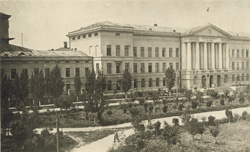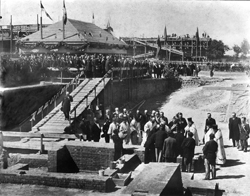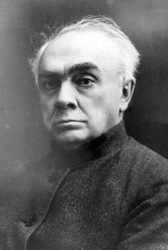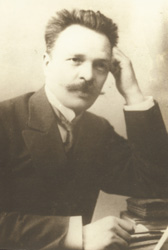|
|
The history of the University
The National Mining University, which is the basic higher mining educational institution in Ukraine, was founded on June 16, 1899. It is the oldest university in Dnipropetrovsk region; moreover it laid the basis for more than two tens of educational institutions and scientific-research institutes. Among them there are Dnipropetrovsk Institute of Chemistry and Technology (1930), Dnipropetrovsk Metallurgical Institute (1930), Northern-Caucasian Mining and Metallurgical Institute (1931), Scientific-Research Chemistry Institute named after Melikishvili in Tbilisi (1929), Moscow Welding Institute (1925), All-Union Scientific-Research Designing Technological Institute of Pipe Industry (1929), Institute of Physical Chemistry named after Lev Pisarzhevsky in Kiev (1927), and others. 
The ceremony of Katerynoslav Higher Mining College (KHMC) opening was conducted on October 12, 1899. At the beginning Higher Mining College had two departments � mining and factory ones. The curriculum according to �Statute of KHMC� foresaw 23 disciplines: God�s study, higher mathematics, analytical mechanics, construction mechanics, applied mechanics, mine-factory mechanics, physics, chemistry, electrical mechanics, mineralogy, geology and science on deposits, geodesy, mining art, ore and coal beneficiation, surveying, metallurgy, technology of metals, drawing and drawing geometry, accounting and mine-factory economy, technical translations from German and French, first aid at accidents. The training process was provided by 13 teachers. 
At the very beginning there was founded a two department library, a mineralogical museum, chemical, mechanical and probe laboratories, cabinets in each disciplines. On June 19, 1912 the State Legislative body adopted a bill on restructuring the KHMC into Mining Institute since July 1. At that time there worked outstanding scientists. They were Ya. Grdina, V. Guskov, S. Zaborovsky, L. Ivanov, N. Lebedev, P. Leontovsky, V. Makovsky, L. Pisarzhevsky, M. Protodiakonov, P. Rubin, A. Terpigorev, M. Fedorov, S. Sharbe. The publications of scientific works in technical periodical journals, monographs, study books, atlases testified high scientific potential of the educational institution. The KHMC systematically edited �Proceedings of Katerynoslav Higher Mining College� since 1905. Up to 1917 there had been edited 23 issues of �Proceedings�, published about 500 scientific works including monographs and study books. In the period of the educational institution formation there were established scientific schools and directions: Ya. Grdina became one of the founders of cybernetics, A. Terpigorev and V. Protodiakonov � the school of mining, V. Guskov � beneficiation of minerals, Leontovsky � the school of surveying, geodesy and geometry of deposits, M. Lebedev � geology and stratigraphy of Donbas, P. Rubin � metallurgy and coke chemistry, L. Pisarzhevsky � electron chemistry. In 1918 Katerynoslav Mining Institute opened two new departments: Surveying (closed in 1921) and Geological Prospecting, and obtained the right to award the scientific degree through public defense of scientific dissertation. In 1921 there was created the Mechanical Faculty with two departments: Mining-Factory and Electrical Engineering. The implementation of new specialties was dictated by industry development. Besides, a Workers� Faculty was opened. Beginning since 1930 Mining Institute started training specialists only for mining industry and geological prospecting works. In 1932 there were established faculties instead of the departments: Mining, Electrical Engineering, Geological-Surveying. 
In 1920 � 1930 the process of scientific schools forming was continued. Though during the 1930-s Dnipropetrovsk Mining Institute lost a significant part of its cadre staff (about 30 persons, among which there were outstanding professors) because of political repressions. In 1941, when the war against Nazi had begun, about 300 teachers, staff members and students were recruited to the front. The institute evacuated to Sverdlovsk (Urals) and Karaganda (Kazakhstan), brought a significant part of the equipment and the scientific staff for Sverdlovsk Mining Institute and the Filial of Moscow Mining Institute, which by that time had come to Karaganda too. A great deal of the teaching staff of Dnipropetrovsk Mining Institute occupied engineering positions at mining enterprises of the Urals and Republics of Middle Asia. The activity of the Institute was renewed in 1943, first � in Karaganda, and later � in Dnipropetrovsk. Destroyed educational facilities and laboratories were under reconstruction. Those who survived were coming back from the front. By 1951/1952 academic year there had been completely renewed the building of the Institute, put into operation a boring experimental study range, laboratories, dormitories. In 1951 there was established the Mine-Construction Faculty. Scientific elaborations of the Institute�s teaching staff, student diploma projects of that period were subordinated to the problems of renewing Donetsk, Kryvyi Rih and Nikopol manganous basins. By the 50-th anniversary the Institute had 165 professors, associate professors and lecturers, 34 departments, 22 laboratories, 25 cabinets, a geological museum, library, experimental study range and study experimental workshops. At 4 faculties there studied 1942 students by 9 specialties. In the 1960-s new-built and restored educational and educational-laboratory buildings, three multistoried dormitories for students and post-graduate students, educational-production workshops, a sport building, facilities of an educational-geodesic experimental study range in the village of Orlivshchyna were put into operation. In 1970 at Dnipropetrovsk Mining Institute there worked 474 teachers, including 34 professors. The amount of graduating engineers equaled 1200 persons. The amount of specialists prepared by full-time education was increasing, though part-time and extramural study forms also functioned. In May 1993 according to the results of State accreditation Dnipropetrovsk Mining Institute gained the status of an autonomous IV-accreditation level state higher educational institution and the name of the State Mining Academy of Ukraine. In 1997, the President of Ukraine issued a decree to award the Academy the national status. In February 2002 the institution was restructured into the National Mining University. Since 2010 the University has had a research status. Today it is one of the leading technical higher educational institutions of the country. The University graduates possess the knowledge in modern computer technologies, and are capable of solving complicated problems of industry, economics and law development. At the University there are 51 departments (27 of which are major-based) united into 9 faculties of full-time education, Institute of Extramural and Distance Learning, post-graduate and doctoral courses, Interbranch Institute of Continuing Learning, Scientific and Research Unit, Ukrainian-American Linguistic Center, Linguistic Center, Ukrainian German Cultural Center, Ukrainian-Spanish-Latin-American Center, Center for Ukrainian-Polish Cooperation, Energy Saving and Energy Management Center, Prydniprovsk Science-and-Technology Center of Information Protection, Ukrainian-American Lyceum, Marganets College, Pavlograd Technical School, Motor Transport Technical School et al. At the University there study 12000 students, post-graduate and doctoral students in 27 modern specialties. The licensed amount of student admission for entering the University is 1400 students. The academic process is provided by 600 teachers including more than 100 Doctor of science, professors and 350 Candidate of Science, associate professors. A high quality of education is guaranteed due to the developed infrastructure of the University, modern computer local and global computer nets, library funds with more than one million of volumes, strong material and technical laboratory basis, newest technologies of education. |

